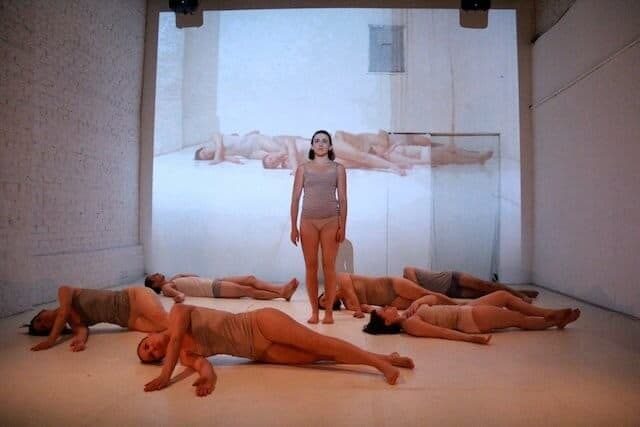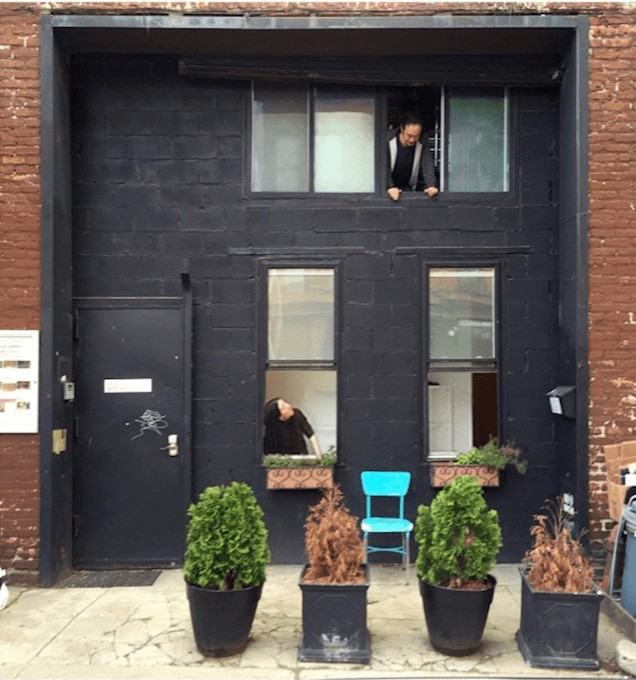
[UPDATE: After this article was published, Sonny Mukhopadhyay reached out to Brokelyn to clarify the situation between CAVE and the Mukhopadhyay family. After Mr. Mukhopadhyay’s passing, his wife — Sonny’s mother — took over the property, and is the “landlord” to which Garnica is referring below. Sonny said that he and his mother “have different opinions” on CAVE’s survival.
“I would rather my mother and them have been able to work this out,” he told us. “I know the CAVE tried to, and wanted to. I don’t agree with the actions she chose to take. I don’t like it, and I am not happy with it.”
When asked whether his mother might have had anything to do with the anonymous 311 call in January, Mukhopadhyay replied, “Until recently she thought that 311 was just a help line for hot water, no heat. I tried to tell her what it’s for, I still don’t think she’s getting it.”]
***
Earlier this year, tipped off by an anonymous 311 call, an inspector from the Department of Buildings knocked on the door of a first-floor DIY space at 58 Grand St. in Williamsburg. According to the tenant who came to the door, the inspector walked in without a permit and immediately began taking pictures with his phone of the unit’s interior partitions, moving through bedrooms where a half-dozen artists had made their homes in the live/work space known as CAVE/Leimay, owned by multidisciplinary artists Ximena Garnica and Shige Moriya.
You’d never be able to be able to tell what CAVE was from the street. It’s a garage wedged between two apartment buildings, the lone single-floor building that remains on the block of Grand St. between Wythe and Kent Avenue. The building technically has four “units,” but it’s only once inside that you see how the space has been uniquely organized to suit its multi-function: A tall white curtain creates a ceiling-height separation between the rehearsal studio and a makeshift “hallway,” which leads to tightly packed tenants’ quarters in the back. The studio space itself is a kind of art-gallery-meets-box-theater, a pristine brick room painted white with dance floors scuffed from years of use by resident artists.
Given the DOB’s restrictive policies on building specifications viz. use, it’s not uncommon for DIY artist spaces like CAVE to get slapped with violations. Lucky for Garnica and Moriya, the Department of Buildings’ visit in January resulted only in fines for illegal conversion, and not an eviction notice.
Still, while they emerged “relatively safe” from eviction “for now,” the impromptu visit was a painful reminder of the space’s contentious existence in a changing borough whose residential by-laws are becoming increasingly hostile to its artist population. Garnica and Moriya’s CAVE/Leimay has provided affordable rehearsal space, artist residencies, performance opportunities and a home — both figuratively and literally — to artists for over 20 years. What differentiates them from the swaths of NYC tenants who willfully break the rules is that they’ve actually been trying to play by them.
__________

Garnica and Moriya had dutifully filed for Loft Law in 2014, a status which allows tenants to secure their spaces as live/work without threat of harassment or eviction by the DOB or their landlords. Their application has been pending for over three years, due in part to the Loft Law’s 2010 amendments by then-Mayor Michael Bloomberg with what Garnica sees as “exclusionary language” designed to allow building owners to “avoid their responsibilities and aggressively resist the registration of their buildings with the Loft Board.”
The specifications of that language include mandatory windows in every residential unit which opens out onto a street or courtyard as well as a minimum of 550 sq. ft. in each unit. Neither of which CAVE has implemented, judging by the New York Times’ 2016 feature about a tenant who was paying $450/month to reside in a “40-sq. ft. cubbyhole tucked into the ceiling of a performance space” not explicitly named as CAVE but easily discernible as such from photos.
To make matters worse, CAVE is registered under a shared address at 58-60 Grand St., and the DOB’s records show a messy history of work orders, stop-work orders and pending violations bound up in the goings-on of the building next door. It’s impossible to get the building up to code pursuant to the 2010 Loft Law restrictions without a permit, and a permit can’t be issued while there’s a stop-work order.
Put simply, CAVE’s tenants are locked in a nightmarish real estate limbo.
____________

Since the 311 call, Garnica and Moriya have been fighting to expedite their application, for fear of being evicted. In a recent press release, they called for Mayor De Blasio to “step up to the plate” by removing the 2010 provisions from the Loft Law to “protect live/work tenants and artists in New York City.” A small trials and proceedings court voted CAVE’s case through to the New York City Loft Board, who will make a decision about the building’s eligibility this coming Thursday, May 18.
And what of the landlord? A building owner could expedite the process to get the building approved under Loft Law, but the 3+ year lag time on Garnica and Moriya’s application suggests that the tenants’ relationship with their landlord may be strained.
Garnica confirmed as much.
“The landlord could solve all this by just registering the building,” she said, “and not try to drain us in this legal battle.”
58-60 Grand St. was formerly owned by a couple, Mr. and Mrs. Rama Mukhopadhyay. Relations were civil, if not overtly conducive to the space’s survival. Since Mr. Mukhopadhyay’s passing at the end of 2016, however, the situation has gotten more insidious: The Mukhopadhyays’ son, Sonny, has allegedly taken over his parents’ properties (though 58-60 Grand St. isn’t publicly listed under his holdings on StreetEasy) and is actively resisting Garnica and Moriya’s fight to get up to code.
Mukhopadhyay, a property manager and Brooklyn native whose heroic deeds include donating Christmas lights to Greenpoint and buying his wife $50,000 worth of wedding gowns on Say Yes to the Dress, could not be reached for comment.
___________
https://www.youtube.com/watch?v=18DrB0HllwI
It’s worth noting that anonymous tattling on DIY spaces has become something of a trend since Oakland’s Ghost Ship fire in 2016. Some fear it’s a strain of conservative vigilantism propagated by the alt-right. Just last year, The Experiment Comedy Gallery shuttered overnight after an unexpected visit from a fire marshal (tipped off by an anonymous 311 call) revealed a lack of secondary egress in the basement space; then-tenant Mo Fathelbab blamed a Trump supporter for the call.
Whatever the root cause of CAVE’s woes and the outcome of their forthcoming legal battle, the space’s story has thus far played out like a tragic morality tale read from the wrong side. CAVE/Leimay is indeed a dying breed, but the city operates under the presumption of its extinction as if it were an inevitability.
Even if genuinely affordable live/work housing does crop up elsewhere in the borough, the DOB’s current building restrictions, along with a rental glut, would likely limit such a space to operating in cramped quarters and sans paper trail. It’s easy to see the cycle of 311 tip-offs and city pushback continuing ad infinitum, to the detriment of the artist communities who rely on them for such simple means and meager returns.
Want to get involved? Stand up for live/work rights at a Rally for a Better Loft Law on May 25.
For more on the fate of the post-NEA arts in Brooklyn: @ahoysamantha
Leave a Reply



